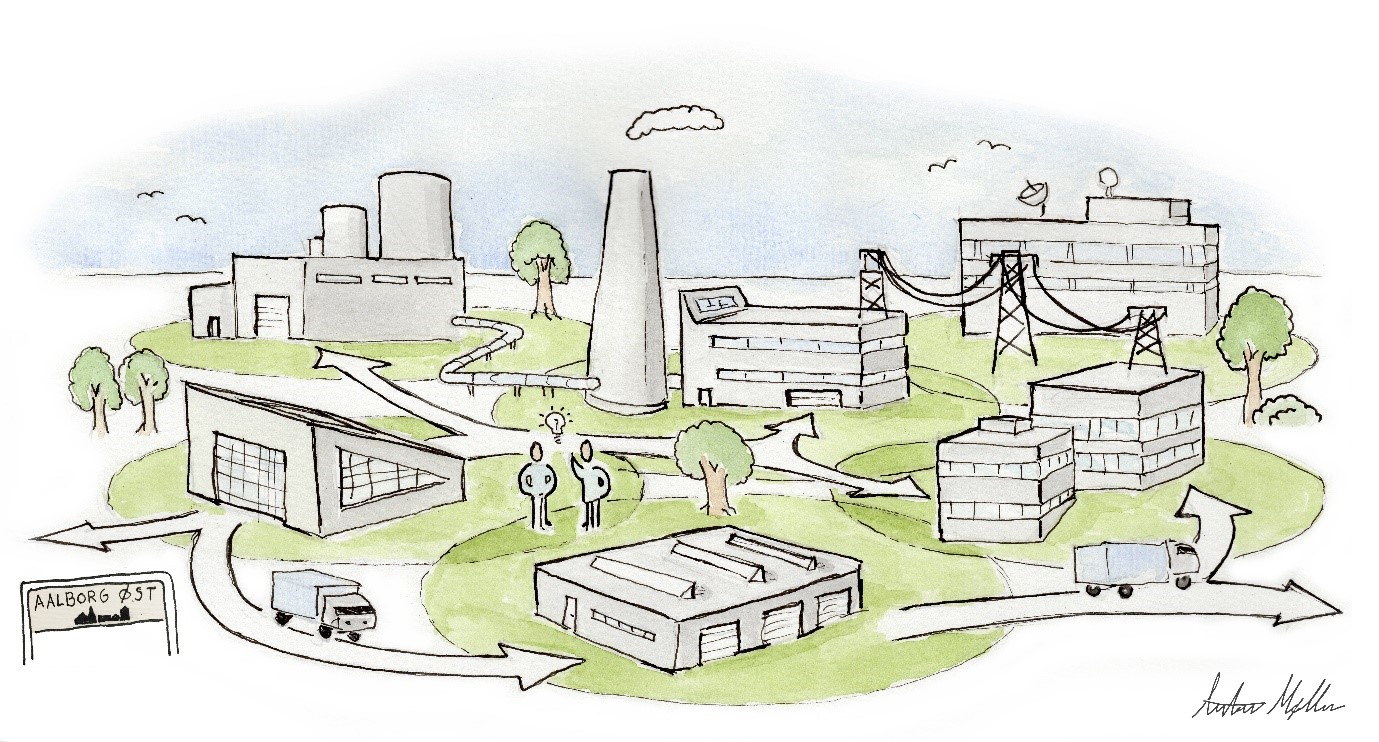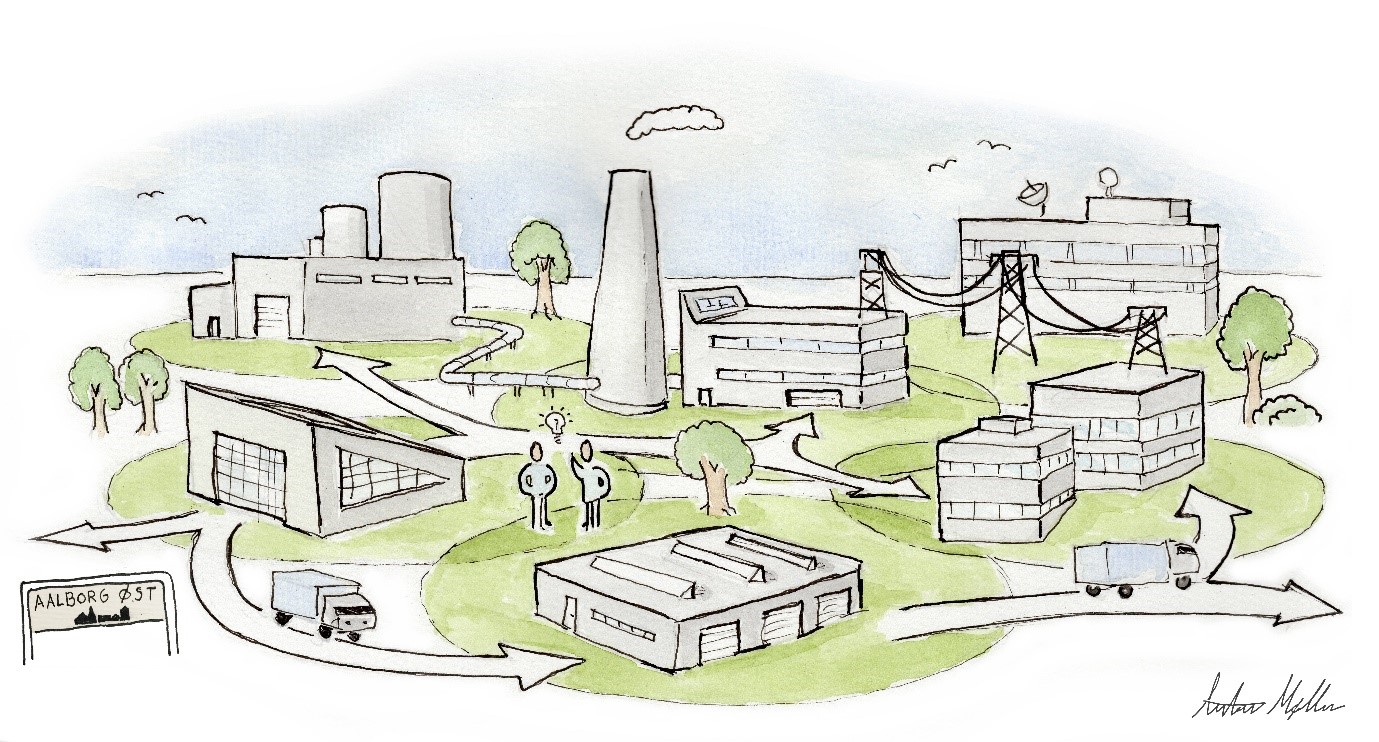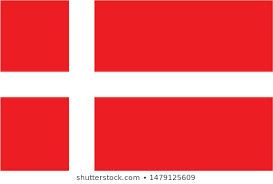S3 facilitates circular economy transition for local companies in Northern Denmark
Denmark
Northern Denmark (2020)
Smart Specialisation partnership facilitates circular economy transition for local companies
Summary of the case
The Northern Denmark Smart Specialisation Strategy (S3) places a strong focus on reinforced local partnerships to achieve innovation-based development. The industrial area of Aalborg – seen in the regional S3 as a key development dynamo – has followed this line by developing a new local partnership to boost industrial symbiosis, in and around the Port of Aalborg, between 2017 and 2020.
The initiative brought SMEs in the Port industrial area together with the University of Aalborg and local public authorities, in addition to public utilities, in an enhanced Entrepreneurial Discovery Process (EDP) focused on green transition. As a result, 42 circular business models for industrial symbiosis were developed involving 25 companies located in the same area, with the help of University facilitators. Together, these new business relationships have led to significant decreases in energy consumption, material use and greenhouse gas emissions. At the same time, they have brought substantial economic benefits thanks to product innovation and savings from the use of waste as resources, as well as radically changing the thinking of many SME managers for good.
A new ‘sustainable business development tool’ – the GAIA tool - was developed to support companies changing their business model. Precise data were collected by the University facilitators on both positive and negative effects of new green business models, whilst under development, as well as during and after implementation. Capitalizing on this pilot experience, the Port of Aalborg now increasingly acts as an integrator, promoting collaboration and symbiotic development of businesses and the local community, ensuring the diffusion of the experiment for the benefit of the whole region.
The findings from the experimentation in the Aalborg Port industrial area illustrate how such areas can evolve to drive sustainable growth, by building real trust through strong and lasting partnership between the different players involved. The key elements of the S3 approach - a holistic development perspective, an enlarged EDP, improved governance models and smarter monitoring systems, have all played a part in nurturing and adding value to these achievements. The fact that the industrial area in question can be considered relatively ‘normal’, or ‘standard’, makes this an inspiring case of strong relevance for a great many similar industrial areas throughout Europe.
1. Territorial context and challenge faced
The area around the Port of Aalborg is the most industrialised part of Northern Denmark. The Port has been a vital hub for trade and industry for centuries, not only for Denmark but also for Scandinavia as a whole. The area combines a port function with that of an industrial and business park. The industrial area of Aalborg is progressively evolving towards a more knowledge-based development, benefiting from the presence of Aalborg University, with its long history of working closely with industry in Denmark and internationally. In line with the Smart Specialisation concept, the Port of Aalborg has developed a strategy to differentiate itself from other ports. Aalborg’s ‘Intelligent Port Strategy’ aims to reinforce the partnership between all local stakeholders, evolving from a classic port infrastructure into a knowledge- and development-based, multimodal logistics hub.
Green transformation is a major challenge faced by the Aalborg industrial area. Denmark may have become world famous for its industrial symbiosis complex in Kalundborg, but small, ‘normal’ Danish industrial areas like Aalborg have not yet adopted such practices. Up until very recently, companies in Aalborg, like in many other industrial areas in Denmark, have been insufficiently aware of the need to adapt their business models and to think in a greener and more circular way.
2. Aims and ambition of the initiative
The Regional Strategy for Growth and Development in Northern Denmark - the regional Smart Specialisation Strategy (S3) - places a strong emphasis on in-depth collaboration between all players in the region, particularly around Aalborg, a key development dynamo. In this context, ‘Environment++’, an ambitious strategic collaboration initiative was put in place by a partnership between a large number of local operators from the ‘triple helix’, seeking to turn the Aalborg East business park into an incubator for sustainable practices and circular business models. The fundamental premise of Environment++ is that sustainability is the key to future growth and jobs, and that Aalborg East should establish itself as a development platform for green solutions for the rest of the region.
The project ‘Facilitated Industrial Symbiosis for Energy and Resource Efficiency’ has been implemented under Environment++. The project developed symbiotic relationships between SMEs in the industrial area, with a view to optimising resource use among co-located companies. It sought to make genuine circular business models the new normal for the area, whilst at all costs avoiding ‘greenwashing’.
3. Content and implementation of the initiative
The ‘Facilitated Industrial Symbiosis for Energy and Resource Efficiency’ project was a 2½-year (2017-2020) project based on partnership between the Port of Aalborg, the Danish Centre for Environmental Assessment at Aalborg University, the network of businesses located in the area, public utilities (water, energy) and local authorities.
Specialist facilitators, mobilised under the project, helped companies identify material sources that could be exchanged with other companies, training them to change their way of thinking and to adopt greener business practices. The industrial symbioses were checked for their wider impact on sustainability, with each individual company and its business model viewed as part of a larger system of secondary and derived effects.
To support the identification of green opportunities and benefits, the ‘GAIA’ tool was developed under the project as a simple means of identifying knock-on environmental impacts of the business models. Importantly, GAIA takes a value chain approach to assess sustainability, while SME business models are typically limited to a single part of a value chain, or sometimes just to one business. The University facilitators helped participating companies calculate both positive and negative effects, when developing green business models, guiding them towards true environmental sustainability.
The following are examples of symbioses that were implemented during the lifetime of the project:
- Designer furniture from waste materials;
- Collaboration on reuse of pallets and cardboard;
- Local handling of oil-mixed liquids;
- Repair of white goods and power tools;
- Transition to renewable energy based production;
- Recycling of plastic sheets and agri-foil;
- Product development based on resource-thinking;
- Symbiosis showing the way to recycling glass fibre;
- Leasing of industrial transportation equipment.
The project was supported by mainstream ERDF from the Operational Programme Innovation and Sustainable Growth in Businesses 2014-2020 and a substantial investment by Port of Aalborg. The latter was a necessary component to allow for the participation of the University, which does not itself have budget lines to co-finance ERDF grants.
Expanded Entrepreneurial Discovery Process
In line with the S3 Entrepreneurial Discovery Process (EDP) approach, the initiative broadened partnerships beyond the one-to-one business-research collaboration that was already prevalent in the region, due to the closeness of Aalborg University with companies. Active involvement of local SMEs was ensured by ‘Business network 9220’, the association of businesses in the area the House of Energy, a cluster for sustainable energy technologies. Broader inclusiveness was achieved through the participation of several public partners, including the Port Authority, local authorities and public utilities – who all played important roles in the initiative. A better integration of the planning departments of local authorities was seen as a value-added of the development strategy. As a result of the project, industrial symbioses are now taken into account in spatial planning strategies in the area.
The interaction between university and businesses brought benefits for all parties. Latest research results, knowledge and insights from the University were often decisive in assessing green business development opportunities. At the same time, research partners also gained new knowledge throughout the project, including through a Business PhD collaboration with the Port of Aalborg.
Governance structure
A specific governance model was implemented for the initiative. A Reference Group was set up, consisting of all local partners from the ‘triple helix’ with an enhanced role for local authorities. In addition, national authorities were involved (i.e. the Danish Business Authority) as well as a representative from the Kalundborg symbiosis, with the aim of learning and exchanging with other sister projects beyond the region.
Thanks to the Environment++ initiative, the Port of Aalborg has taken up a new role in facilitating industrial symbioses, as experimented upon in the project, as well as generally playing a more prominent role in the economic development of the area. The project was also supported by an Industrial PhD, who followed its implementation in order to describe the role and importance of facilitation for the emergence of industrial symbioses.
Monitoring for green and economic impacts
The experimentation carried out under the project was accompanied by detailed monitoring, using a system jointly developed by companies and researchers aimed at gathering data on both environmental and economic impacts. After the project, the monitoring work was transferred to and further used by the Port Authority. The university continues the work on the assessment of economic benefits from industrial symbioses and plans publications in this subject area, based on real-life experimentation.
4. Achievements
Working with more than 25 companies, the project developed 42 green business models for industrial symbiosis. Together these new business relationships have led to significant decreases in energy consumption, material use and greenhouse gas emissions. At the same time, they have brought substantial economic benefits thanks to product innovation and savings from the use of waste as resources.
Environmental benefits
The industrial symbioses will achieve energy savings of more than 3,000 KWh and CO2 emissions reductions totalling 10,000 tonnes per year. This is considerably more than expected, highlighting that industrial symbiosis is vital in helping companies become greener. Beyond the reduction of energy and greenhouse gases, the symbioses have several other beneficial environmental impacts. The project led to high material savings, whilst also helping to minimize the transport of materials via trucks, implying less air pollution and less micro plastic from wear and tear of tires.
Economic benefits
The symbioses created under the project also generated considerable economic benefits - direct economic gains, as well as other positive effects, which, indirectly or in the long-term, can lead to an improved bottom line for companies. The range of benefits observed in the project is wide:
- Reduction of waste disposal costs;
- Lower material purchasing costs;
- Income through product innovation and new products;
- New markets or customer groups;
- Capacity and competence building;
- Improved company culture and work ethics;
- Improved image for the company;
- Social benefits and job creation.
These economic benefits differ between symbioses, but mean data have been calculated as follows:
- €140,000/year: the typical direct value of symbioses that create new products and product innovation;
- €4,000-7,000/year: the typical direct value of symbioses that use the waste of one company in the production process of another.
Several lessons were learnt for successful industrial symbioses, as follows, paving the way to green transition of industrial areas:
- Many untapped symbiosis opportunities exist and can be realised when adequate relationships are created between companies. Facilitation plays a key role for obtaining such benefits;
- Environmental assessment is needed during business development to test sustainability and avoid greenwashing - as demonstrated by the successful use of the GAIA tool;
- New and digital technologies are not sufficient - there is a need for mentality change throughout the system;
- Symbioses breed symbioses. It is a cumulative process.
Key success factors in this experiment were the strong partnership among the local actors involved, the investment of necessary resources to facilitate the business development which took place and the Port of Aalborg’s strategic vision, which played the vital catalytic role.
5. Replicability
The Industrial Symbiosis experience in Aalborg East has a high degree of replicability. It is also sustainable in the sense that it will continue after the end of the public funding, ensuring lasting impacts. SMEs involved in the project have changed their mindset by thinking in a more systemic way and will continue to search for profitable synergies in the future. The availability of the GAIA tool offers practical support for replication of this new orientation toward green business models.
The Port of Aalborg has further developed its integrator mission, by hiring facilitators from the project on a permanent basis, to support further interactions and the search for synergies between companies in the industrial park. The Port is planning to offer such facilitation services for a fee, possibly offset against future company savings from symbioses, with a view to ensuring commercial viability of the model. The spatial planning procedures of the Municipality have already been adjusted to take better account of the need and possibilities for industrial symbiosis.
New internships and Industrial PhDs at Aalborg University, attracted by the favourable environment, will continue the cross-fertilisation between research and green business development. At the national level, Environment++ has become part of the ‘Ambition Green Hub Denmark’ partnership, where exchanges with several ‘sister projects’ are taking place. The experience of Aalborg in transforming an existing industrial area attracts much attention, as it complements other industrial symbiosis initiatives that tend to focus on greenfield investments.
Overall, the project demonstrated how an industrial area considered ‘normal’, or ‘standard’, can make an important leap towards green business development, which is a true inspiration for a great many similar industrial areas throughout Europe.
"In Aalborg East, we want to be the world’s most sustainable industrial area. It is a very ambitious vision, but we have all the right building blocks for it and a fantastic, shared enthusiasm."
Mette Schmidt, chairman of Business Network 9220

Møller, A. 2017. Illustration for the project Sustainable Synergies: Facilitated industrial symbiosis for energy- and resource efficiency. Copyright: The Danish Centre for Environmental Assessment, Aalborg University

In Aalborg East, we want to be the world’s most sustainable industrial area. It is a very ambitious vision, but we have all the right building blocks for it and a fantastic, shared enthusiasm.
Additional Information
Contact:
Lone Kørnøv - Aalborg University
Email: lonek@plan.aau.dk
Tel: +45 23104448
Websites:
- ‘Facilitated Industrial Symbiosis for Energy and Resource Efficiency’ project.
- ’Green Business development through Industrial Symbiosis. The GAIA model’.
- ‘The Intelligent Port’. Port of Aalborg’s strategy.
- The Kalundborg Symbiosis.

